Economic Analysis: Unemployment and Inflation Dynamics in the USA
VerifiedAdded on 2023/06/10
|17
|3582
|314
Report
AI Summary
This report undertakes an analysis of the relationship between unemployment and inflation, focusing on the economic dynamics within the United States. It begins with an introduction that highlights the significance of these economic indicators and their impact on national well-being. The report then proceeds to a comprehensive literature review, defining unemployment and inflation, and exploring their implications. It also delves into the Phillips Curve theory, which suggests an inverse relationship between the two. The report presents and analyzes data on unemployment and the Consumer Price Index (CPI) in the USA from 2008 to 2017. The methodology involves regression analysis to model the relationship between inflation and unemployment. The results are then discussed in relation to the Phillips Curve, comparing empirical evidence with theoretical assertions. The report concludes by summarizing the findings and their implications for understanding the interplay between inflation and unemployment in the US economy.
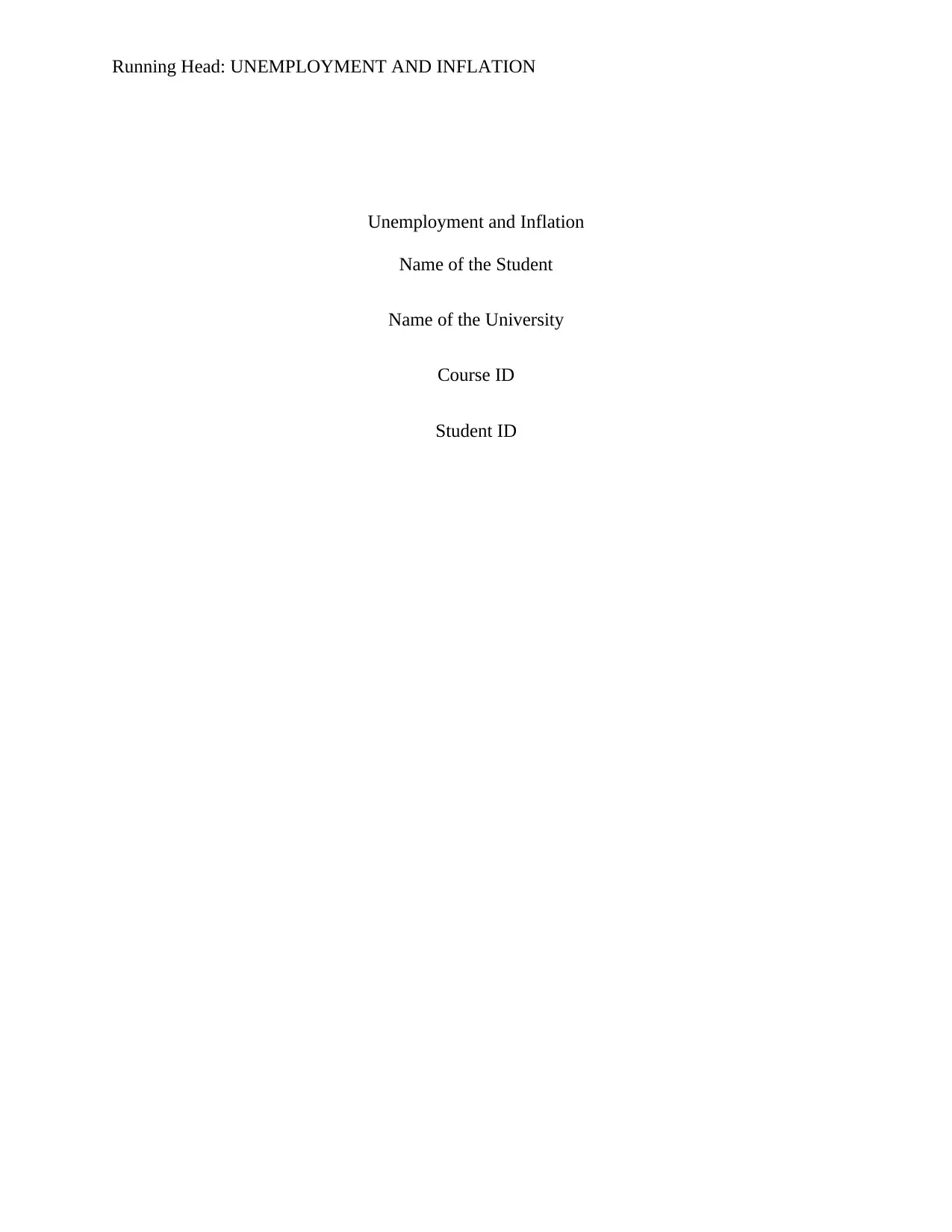
Running Head: UNEMPLOYMENT AND INFLATION
Unemployment and Inflation
Name of the Student
Name of the University
Course ID
Student ID
Unemployment and Inflation
Name of the Student
Name of the University
Course ID
Student ID
Paraphrase This Document
Need a fresh take? Get an instant paraphrase of this document with our AI Paraphraser
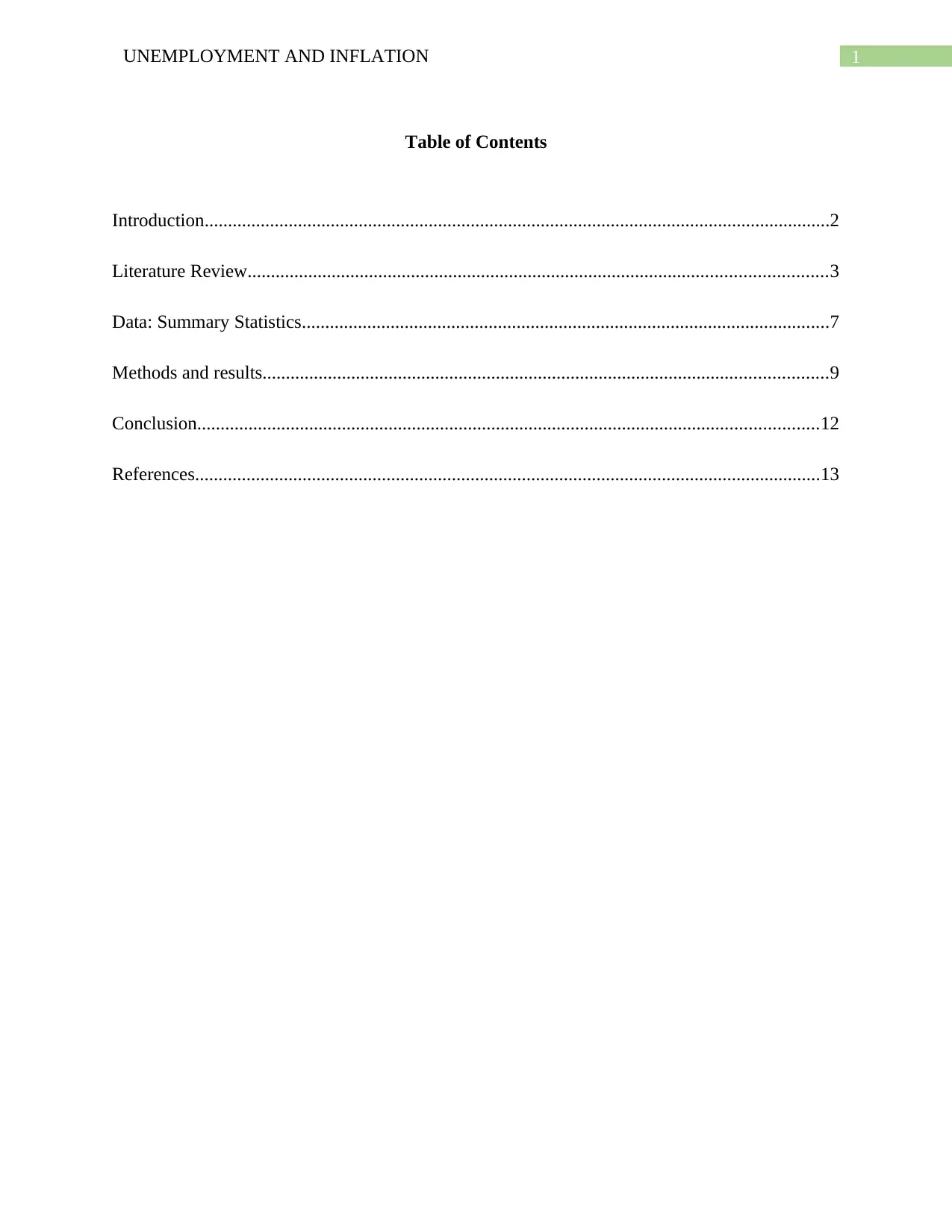
1UNEMPLOYMENT AND INFLATION
Table of Contents
Introduction......................................................................................................................................2
Literature Review............................................................................................................................3
Data: Summary Statistics.................................................................................................................7
Methods and results.........................................................................................................................9
Conclusion.....................................................................................................................................12
References......................................................................................................................................13
Table of Contents
Introduction......................................................................................................................................2
Literature Review............................................................................................................................3
Data: Summary Statistics.................................................................................................................7
Methods and results.........................................................................................................................9
Conclusion.....................................................................................................................................12
References......................................................................................................................................13

2UNEMPLOYMENT AND INFLATION
Introduction
The economy of different countries and the dynamics experienced in the path of progress
of the same, in turn depends on the performance of the different indicators and economic
variables, which by measuring the progress of the economy of the concerned country in different
aspects, highlight the overall position of the economy of the country in the global scenario as
well as the economic well-being of the population of the concerned countries (Agénor &
Montiel, 2015).
The different economic indicators of immense importance, which are usually taken into
account for measuring the economic progress and condition of different countries across the
globe primarily include those of the Gross Domestic Product, the level of unemployment, price
levels as well as the import export dynamics of the countries (Agénor & Montiel, 2015). Of
these, the level of unemployment acts as a significant indicator as much of the economic well-
being of the population of the country as well as the overall health of the economy as a whole
and its productivity and prosperity depend inversely on the same.
There are different factors in the economy, which also have considerable influences on
the unemployment dynamics of the countries in a period of time. One of such factors is that of
the inflation scenario or the average levels of prices prevailing in an economy at a point of time.
According to the theory of Phillips Curve, there lies an inverse relationship between these two
economic indicators with the logic being increase in economic growth leads to an overall
increase in the productivity as well as inflation due to high demand for commodities and
services, which in turn is expected to create more employment scopes, thereby decreasing
unemployment in the economy (Fitzgerald & Nicolini, 2014). Keeping this into consideration,
the concerned report tries to analyse the influence of the price levels in the USA on the
Introduction
The economy of different countries and the dynamics experienced in the path of progress
of the same, in turn depends on the performance of the different indicators and economic
variables, which by measuring the progress of the economy of the concerned country in different
aspects, highlight the overall position of the economy of the country in the global scenario as
well as the economic well-being of the population of the concerned countries (Agénor &
Montiel, 2015).
The different economic indicators of immense importance, which are usually taken into
account for measuring the economic progress and condition of different countries across the
globe primarily include those of the Gross Domestic Product, the level of unemployment, price
levels as well as the import export dynamics of the countries (Agénor & Montiel, 2015). Of
these, the level of unemployment acts as a significant indicator as much of the economic well-
being of the population of the country as well as the overall health of the economy as a whole
and its productivity and prosperity depend inversely on the same.
There are different factors in the economy, which also have considerable influences on
the unemployment dynamics of the countries in a period of time. One of such factors is that of
the inflation scenario or the average levels of prices prevailing in an economy at a point of time.
According to the theory of Phillips Curve, there lies an inverse relationship between these two
economic indicators with the logic being increase in economic growth leads to an overall
increase in the productivity as well as inflation due to high demand for commodities and
services, which in turn is expected to create more employment scopes, thereby decreasing
unemployment in the economy (Fitzgerald & Nicolini, 2014). Keeping this into consideration,
the concerned report tries to analyse the influence of the price levels in the USA on the
⊘ This is a preview!⊘
Do you want full access?
Subscribe today to unlock all pages.

Trusted by 1+ million students worldwide
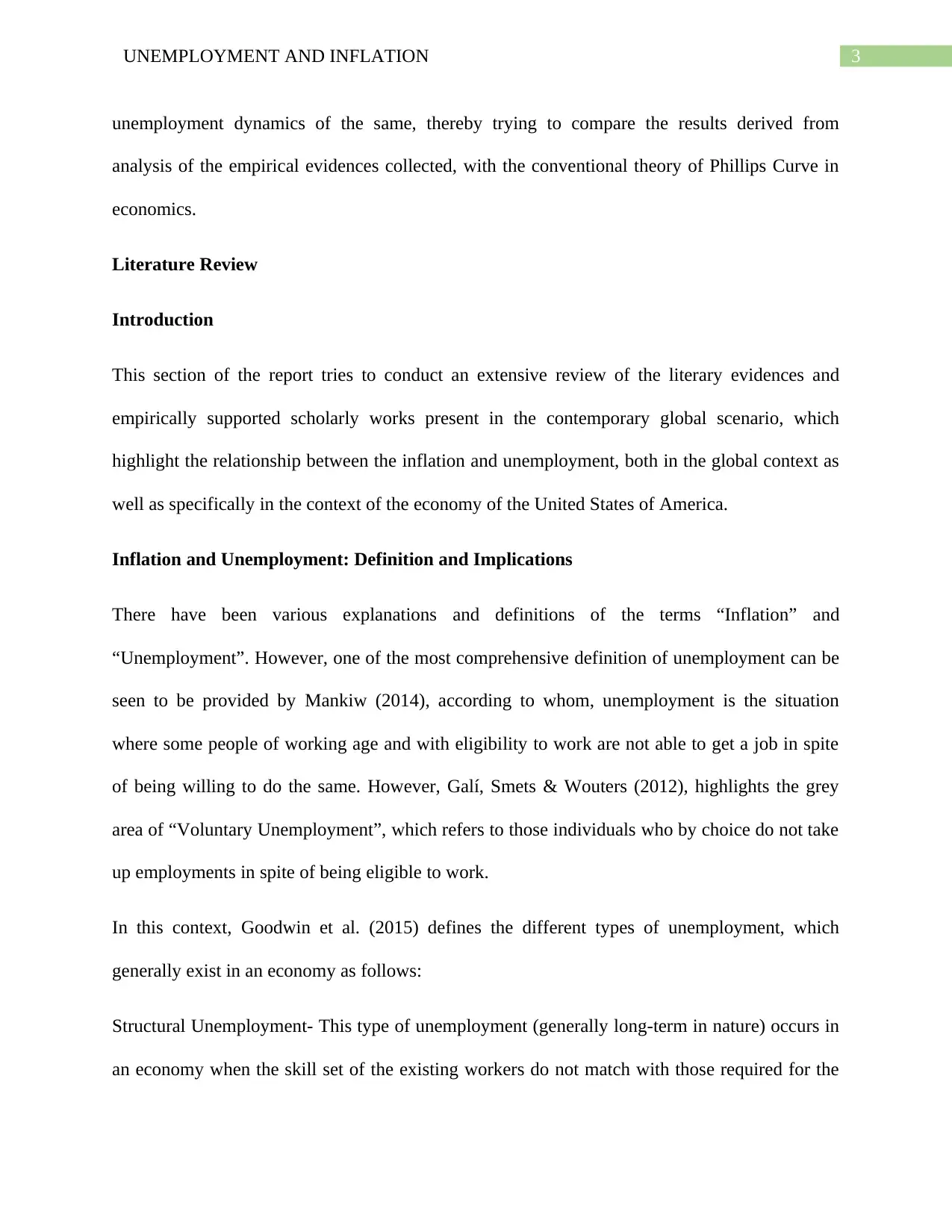
3UNEMPLOYMENT AND INFLATION
unemployment dynamics of the same, thereby trying to compare the results derived from
analysis of the empirical evidences collected, with the conventional theory of Phillips Curve in
economics.
Literature Review
Introduction
This section of the report tries to conduct an extensive review of the literary evidences and
empirically supported scholarly works present in the contemporary global scenario, which
highlight the relationship between the inflation and unemployment, both in the global context as
well as specifically in the context of the economy of the United States of America.
Inflation and Unemployment: Definition and Implications
There have been various explanations and definitions of the terms “Inflation” and
“Unemployment”. However, one of the most comprehensive definition of unemployment can be
seen to be provided by Mankiw (2014), according to whom, unemployment is the situation
where some people of working age and with eligibility to work are not able to get a job in spite
of being willing to do the same. However, Galí, Smets & Wouters (2012), highlights the grey
area of “Voluntary Unemployment”, which refers to those individuals who by choice do not take
up employments in spite of being eligible to work.
In this context, Goodwin et al. (2015) defines the different types of unemployment, which
generally exist in an economy as follows:
Structural Unemployment- This type of unemployment (generally long-term in nature) occurs in
an economy when the skill set of the existing workers do not match with those required for the
unemployment dynamics of the same, thereby trying to compare the results derived from
analysis of the empirical evidences collected, with the conventional theory of Phillips Curve in
economics.
Literature Review
Introduction
This section of the report tries to conduct an extensive review of the literary evidences and
empirically supported scholarly works present in the contemporary global scenario, which
highlight the relationship between the inflation and unemployment, both in the global context as
well as specifically in the context of the economy of the United States of America.
Inflation and Unemployment: Definition and Implications
There have been various explanations and definitions of the terms “Inflation” and
“Unemployment”. However, one of the most comprehensive definition of unemployment can be
seen to be provided by Mankiw (2014), according to whom, unemployment is the situation
where some people of working age and with eligibility to work are not able to get a job in spite
of being willing to do the same. However, Galí, Smets & Wouters (2012), highlights the grey
area of “Voluntary Unemployment”, which refers to those individuals who by choice do not take
up employments in spite of being eligible to work.
In this context, Goodwin et al. (2015) defines the different types of unemployment, which
generally exist in an economy as follows:
Structural Unemployment- This type of unemployment (generally long-term in nature) occurs in
an economy when the skill set of the existing workers do not match with those required for the
Paraphrase This Document
Need a fresh take? Get an instant paraphrase of this document with our AI Paraphraser
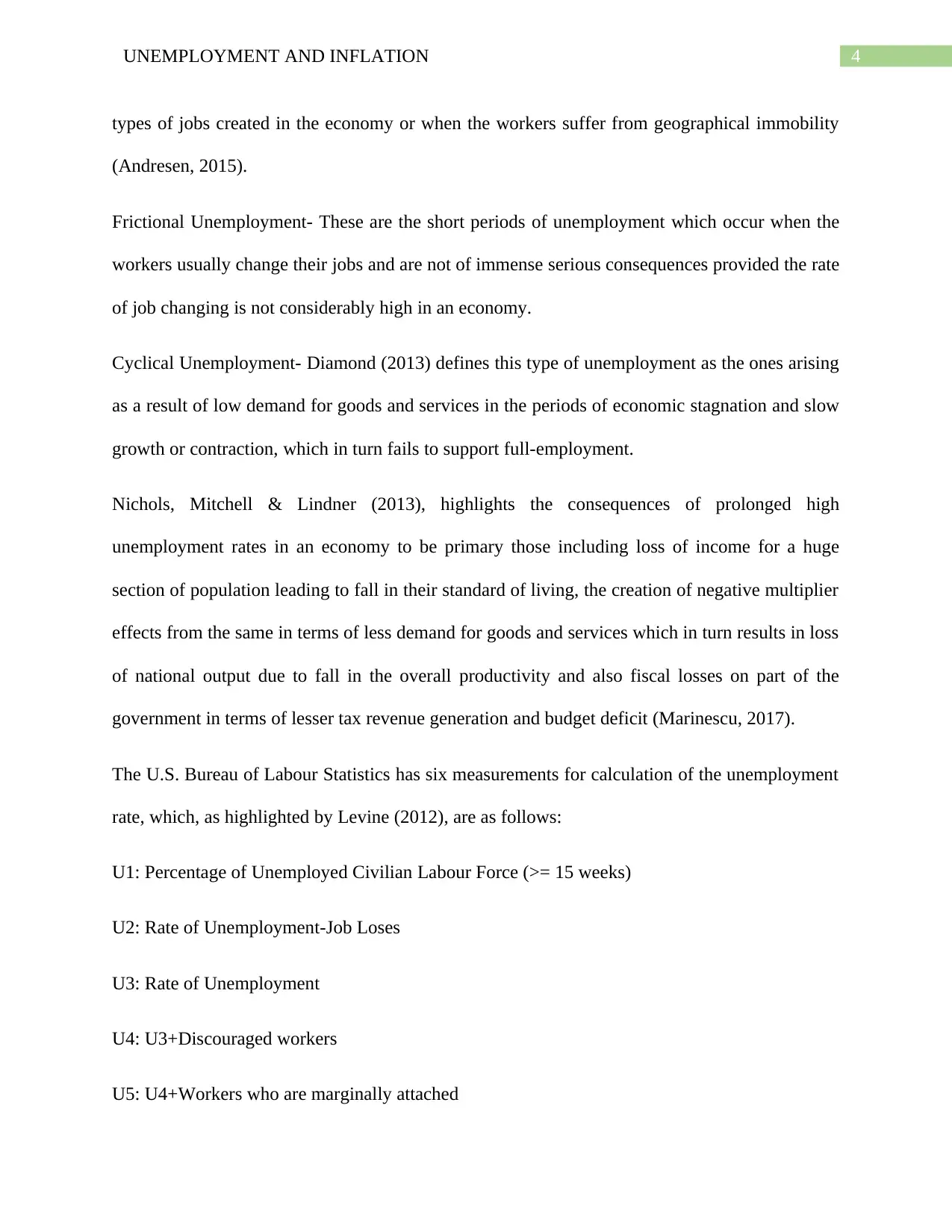
4UNEMPLOYMENT AND INFLATION
types of jobs created in the economy or when the workers suffer from geographical immobility
(Andresen, 2015).
Frictional Unemployment- These are the short periods of unemployment which occur when the
workers usually change their jobs and are not of immense serious consequences provided the rate
of job changing is not considerably high in an economy.
Cyclical Unemployment- Diamond (2013) defines this type of unemployment as the ones arising
as a result of low demand for goods and services in the periods of economic stagnation and slow
growth or contraction, which in turn fails to support full-employment.
Nichols, Mitchell & Lindner (2013), highlights the consequences of prolonged high
unemployment rates in an economy to be primary those including loss of income for a huge
section of population leading to fall in their standard of living, the creation of negative multiplier
effects from the same in terms of less demand for goods and services which in turn results in loss
of national output due to fall in the overall productivity and also fiscal losses on part of the
government in terms of lesser tax revenue generation and budget deficit (Marinescu, 2017).
The U.S. Bureau of Labour Statistics has six measurements for calculation of the unemployment
rate, which, as highlighted by Levine (2012), are as follows:
U1: Percentage of Unemployed Civilian Labour Force (>= 15 weeks)
U2: Rate of Unemployment-Job Loses
U3: Rate of Unemployment
U4: U3+Discouraged workers
U5: U4+Workers who are marginally attached
types of jobs created in the economy or when the workers suffer from geographical immobility
(Andresen, 2015).
Frictional Unemployment- These are the short periods of unemployment which occur when the
workers usually change their jobs and are not of immense serious consequences provided the rate
of job changing is not considerably high in an economy.
Cyclical Unemployment- Diamond (2013) defines this type of unemployment as the ones arising
as a result of low demand for goods and services in the periods of economic stagnation and slow
growth or contraction, which in turn fails to support full-employment.
Nichols, Mitchell & Lindner (2013), highlights the consequences of prolonged high
unemployment rates in an economy to be primary those including loss of income for a huge
section of population leading to fall in their standard of living, the creation of negative multiplier
effects from the same in terms of less demand for goods and services which in turn results in loss
of national output due to fall in the overall productivity and also fiscal losses on part of the
government in terms of lesser tax revenue generation and budget deficit (Marinescu, 2017).
The U.S. Bureau of Labour Statistics has six measurements for calculation of the unemployment
rate, which, as highlighted by Levine (2012), are as follows:
U1: Percentage of Unemployed Civilian Labour Force (>= 15 weeks)
U2: Rate of Unemployment-Job Loses
U3: Rate of Unemployment
U4: U3+Discouraged workers
U5: U4+Workers who are marginally attached

5UNEMPLOYMENT AND INFLATION
U6: U5+part time workers for economic reasons
On the other hand, Ascari & Sbordone (2014), define inflation as the situation of sustained
increase in the average price levels of goods and services in a country which in turn leads to an
increase in the cost of living of the residents in the same.
There are in general two types of inflation, which are defined by Johnson (2017), to be as
follows:
Demand-Pull Inflation- This is caused due to an increase in the demand for goods and services,
the demand being higher than the supply increase, thereby leading to an upward pressure on the
price levels.
Cost-Push Inflation- This leads to an increase in the price levels of commodities due to an
increase in the price of the materials used for production of the same, thereby leading to an
increase in the cost of production (Summa & Serrano, 2015).
Inflation is most commonly measured by the Consumer Price Index (Finland, 2013). This index
is the weighted average of the prices of goods and services of a pre-determined commodity
basket, with the price being measured in each successive year, thereby measuring the change in
the price of the basket with time, which in turn helps in capturing the inflation scenario in the
country (Baker, 2016).
Phillips Curve
The theory of Phillips Curve, as discussed in the work of Gordon (2013), highlights the inverse
relationship between inflation and unemployment. As the author asserts, with the increase in the
economic growth and demands for goods and services, a demand-pull inflation happens and at
U6: U5+part time workers for economic reasons
On the other hand, Ascari & Sbordone (2014), define inflation as the situation of sustained
increase in the average price levels of goods and services in a country which in turn leads to an
increase in the cost of living of the residents in the same.
There are in general two types of inflation, which are defined by Johnson (2017), to be as
follows:
Demand-Pull Inflation- This is caused due to an increase in the demand for goods and services,
the demand being higher than the supply increase, thereby leading to an upward pressure on the
price levels.
Cost-Push Inflation- This leads to an increase in the price levels of commodities due to an
increase in the price of the materials used for production of the same, thereby leading to an
increase in the cost of production (Summa & Serrano, 2015).
Inflation is most commonly measured by the Consumer Price Index (Finland, 2013). This index
is the weighted average of the prices of goods and services of a pre-determined commodity
basket, with the price being measured in each successive year, thereby measuring the change in
the price of the basket with time, which in turn helps in capturing the inflation scenario in the
country (Baker, 2016).
Phillips Curve
The theory of Phillips Curve, as discussed in the work of Gordon (2013), highlights the inverse
relationship between inflation and unemployment. As the author asserts, with the increase in the
economic growth and demands for goods and services, a demand-pull inflation happens and at
⊘ This is a preview!⊘
Do you want full access?
Subscribe today to unlock all pages.

Trusted by 1+ million students worldwide

6UNEMPLOYMENT AND INFLATION
the same time to meet the additional demand, more labor is required, which in turn, leads to a fall
in the unemployment and vice versa.
Figure 1: Phillips Curve
(Source: Forder, 2014)
Augmenting this view, Palley (2012), argues that when in an economy jobs are created, the
standard of living of people starts increasing which in turn increases their demands for goods and
services, thereby increasing the level of inflation in the country. Thus, the relationship between
inflation and unemployment is valid in both the ways.
Evidences for the USA
There have been extensive works in the concerned domain, especially on the economy of the
USA, to compare and contrast the actual trends with the theoretical assertions of the Phillips
the same time to meet the additional demand, more labor is required, which in turn, leads to a fall
in the unemployment and vice versa.
Figure 1: Phillips Curve
(Source: Forder, 2014)
Augmenting this view, Palley (2012), argues that when in an economy jobs are created, the
standard of living of people starts increasing which in turn increases their demands for goods and
services, thereby increasing the level of inflation in the country. Thus, the relationship between
inflation and unemployment is valid in both the ways.
Evidences for the USA
There have been extensive works in the concerned domain, especially on the economy of the
USA, to compare and contrast the actual trends with the theoretical assertions of the Phillips
Paraphrase This Document
Need a fresh take? Get an instant paraphrase of this document with our AI Paraphraser
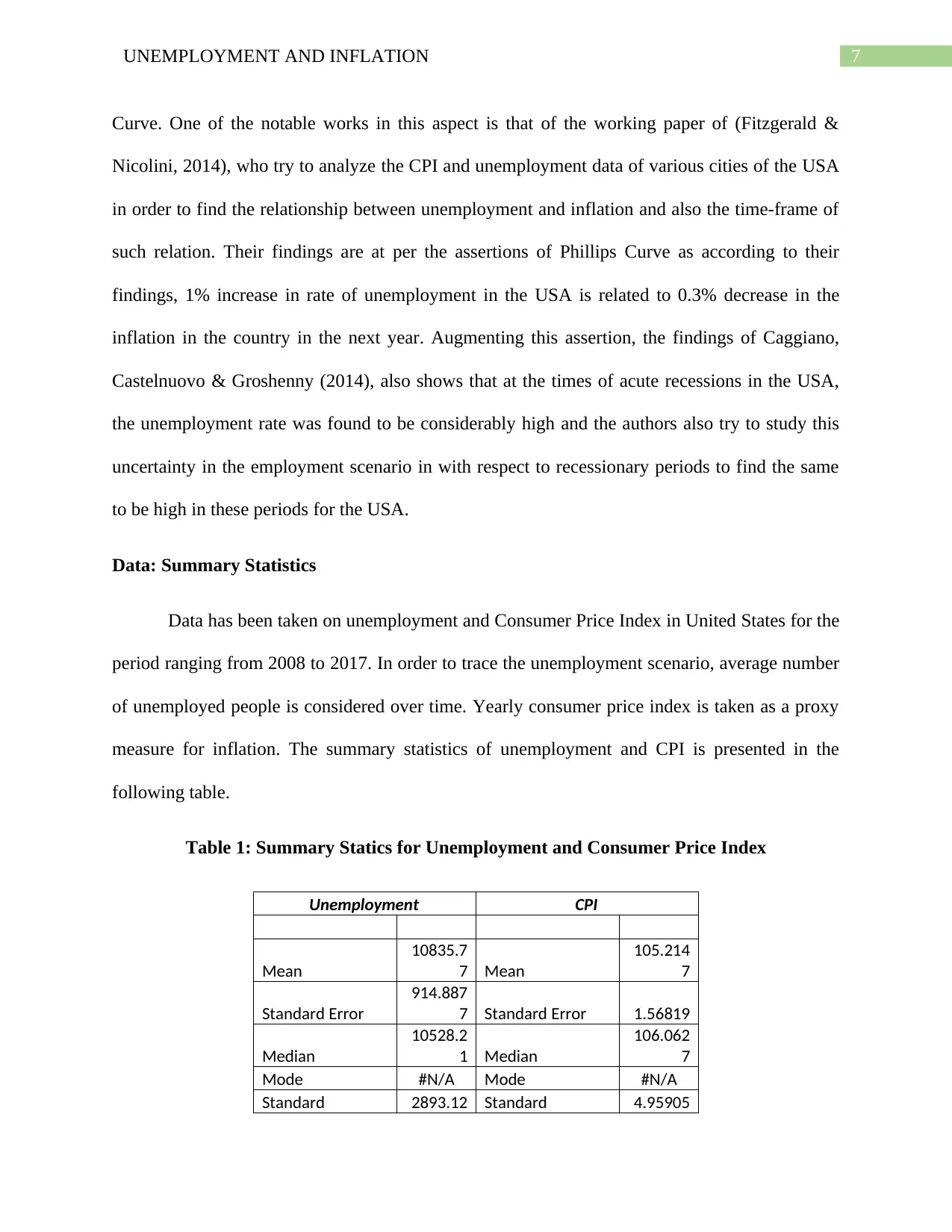
7UNEMPLOYMENT AND INFLATION
Curve. One of the notable works in this aspect is that of the working paper of (Fitzgerald &
Nicolini, 2014), who try to analyze the CPI and unemployment data of various cities of the USA
in order to find the relationship between unemployment and inflation and also the time-frame of
such relation. Their findings are at per the assertions of Phillips Curve as according to their
findings, 1% increase in rate of unemployment in the USA is related to 0.3% decrease in the
inflation in the country in the next year. Augmenting this assertion, the findings of Caggiano,
Castelnuovo & Groshenny (2014), also shows that at the times of acute recessions in the USA,
the unemployment rate was found to be considerably high and the authors also try to study this
uncertainty in the employment scenario in with respect to recessionary periods to find the same
to be high in these periods for the USA.
Data: Summary Statistics
Data has been taken on unemployment and Consumer Price Index in United States for the
period ranging from 2008 to 2017. In order to trace the unemployment scenario, average number
of unemployed people is considered over time. Yearly consumer price index is taken as a proxy
measure for inflation. The summary statistics of unemployment and CPI is presented in the
following table.
Table 1: Summary Statics for Unemployment and Consumer Price Index
Unemployment CPI
Mean
10835.7
7 Mean
105.214
7
Standard Error
914.887
7 Standard Error 1.56819
Median
10528.2
1 Median
106.062
7
Mode #N/A Mode #N/A
Standard 2893.12 Standard 4.95905
Curve. One of the notable works in this aspect is that of the working paper of (Fitzgerald &
Nicolini, 2014), who try to analyze the CPI and unemployment data of various cities of the USA
in order to find the relationship between unemployment and inflation and also the time-frame of
such relation. Their findings are at per the assertions of Phillips Curve as according to their
findings, 1% increase in rate of unemployment in the USA is related to 0.3% decrease in the
inflation in the country in the next year. Augmenting this assertion, the findings of Caggiano,
Castelnuovo & Groshenny (2014), also shows that at the times of acute recessions in the USA,
the unemployment rate was found to be considerably high and the authors also try to study this
uncertainty in the employment scenario in with respect to recessionary periods to find the same
to be high in these periods for the USA.
Data: Summary Statistics
Data has been taken on unemployment and Consumer Price Index in United States for the
period ranging from 2008 to 2017. In order to trace the unemployment scenario, average number
of unemployed people is considered over time. Yearly consumer price index is taken as a proxy
measure for inflation. The summary statistics of unemployment and CPI is presented in the
following table.
Table 1: Summary Statics for Unemployment and Consumer Price Index
Unemployment CPI
Mean
10835.7
7 Mean
105.214
7
Standard Error
914.887
7 Standard Error 1.56819
Median
10528.2
1 Median
106.062
7
Mode #N/A Mode #N/A
Standard 2893.12 Standard 4.95905
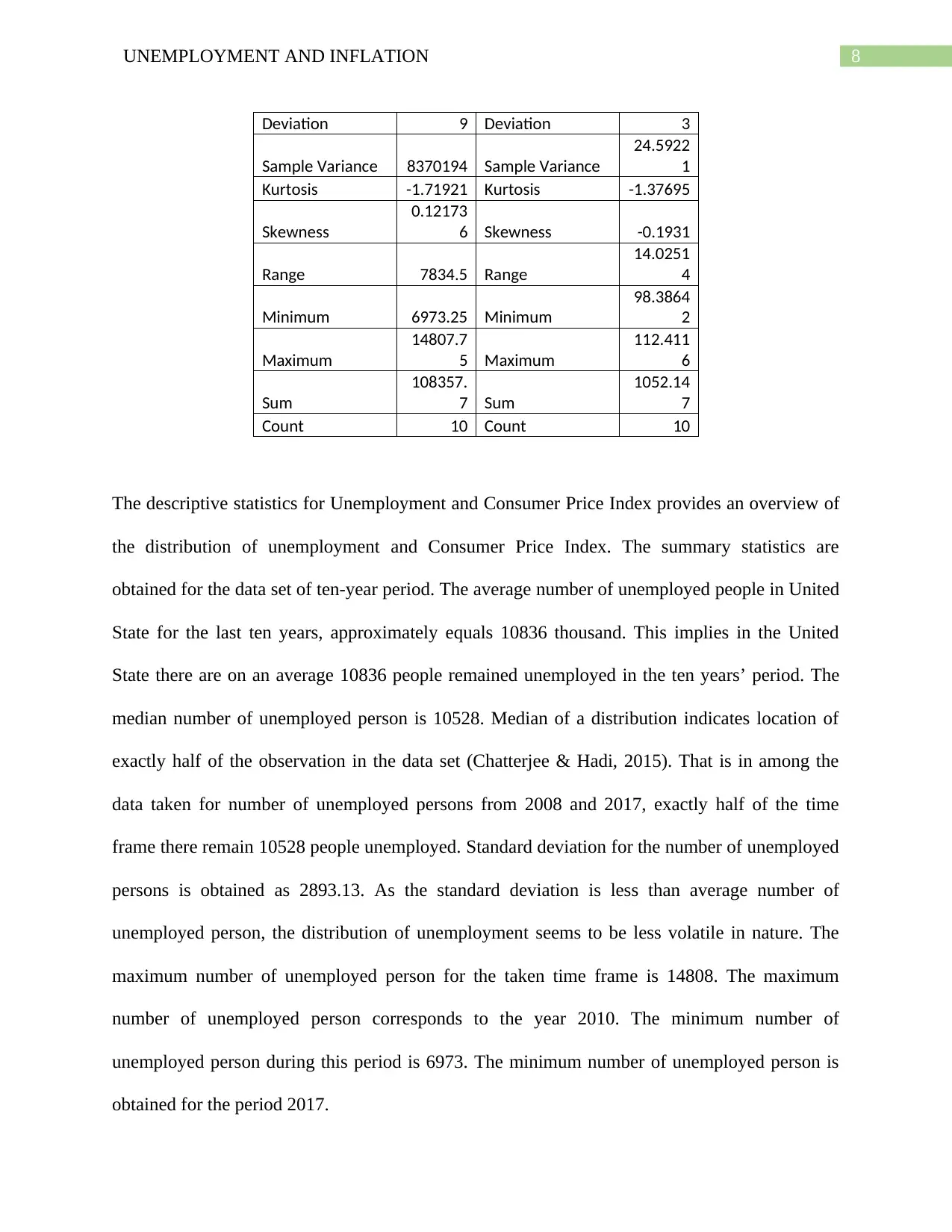
8UNEMPLOYMENT AND INFLATION
Deviation 9 Deviation 3
Sample Variance 8370194 Sample Variance
24.5922
1
Kurtosis -1.71921 Kurtosis -1.37695
Skewness
0.12173
6 Skewness -0.1931
Range 7834.5 Range
14.0251
4
Minimum 6973.25 Minimum
98.3864
2
Maximum
14807.7
5 Maximum
112.411
6
Sum
108357.
7 Sum
1052.14
7
Count 10 Count 10
The descriptive statistics for Unemployment and Consumer Price Index provides an overview of
the distribution of unemployment and Consumer Price Index. The summary statistics are
obtained for the data set of ten-year period. The average number of unemployed people in United
State for the last ten years, approximately equals 10836 thousand. This implies in the United
State there are on an average 10836 people remained unemployed in the ten years’ period. The
median number of unemployed person is 10528. Median of a distribution indicates location of
exactly half of the observation in the data set (Chatterjee & Hadi, 2015). That is in among the
data taken for number of unemployed persons from 2008 and 2017, exactly half of the time
frame there remain 10528 people unemployed. Standard deviation for the number of unemployed
persons is obtained as 2893.13. As the standard deviation is less than average number of
unemployed person, the distribution of unemployment seems to be less volatile in nature. The
maximum number of unemployed person for the taken time frame is 14808. The maximum
number of unemployed person corresponds to the year 2010. The minimum number of
unemployed person during this period is 6973. The minimum number of unemployed person is
obtained for the period 2017.
Deviation 9 Deviation 3
Sample Variance 8370194 Sample Variance
24.5922
1
Kurtosis -1.71921 Kurtosis -1.37695
Skewness
0.12173
6 Skewness -0.1931
Range 7834.5 Range
14.0251
4
Minimum 6973.25 Minimum
98.3864
2
Maximum
14807.7
5 Maximum
112.411
6
Sum
108357.
7 Sum
1052.14
7
Count 10 Count 10
The descriptive statistics for Unemployment and Consumer Price Index provides an overview of
the distribution of unemployment and Consumer Price Index. The summary statistics are
obtained for the data set of ten-year period. The average number of unemployed people in United
State for the last ten years, approximately equals 10836 thousand. This implies in the United
State there are on an average 10836 people remained unemployed in the ten years’ period. The
median number of unemployed person is 10528. Median of a distribution indicates location of
exactly half of the observation in the data set (Chatterjee & Hadi, 2015). That is in among the
data taken for number of unemployed persons from 2008 and 2017, exactly half of the time
frame there remain 10528 people unemployed. Standard deviation for the number of unemployed
persons is obtained as 2893.13. As the standard deviation is less than average number of
unemployed person, the distribution of unemployment seems to be less volatile in nature. The
maximum number of unemployed person for the taken time frame is 14808. The maximum
number of unemployed person corresponds to the year 2010. The minimum number of
unemployed person during this period is 6973. The minimum number of unemployed person is
obtained for the period 2017.
⊘ This is a preview!⊘
Do you want full access?
Subscribe today to unlock all pages.

Trusted by 1+ million students worldwide
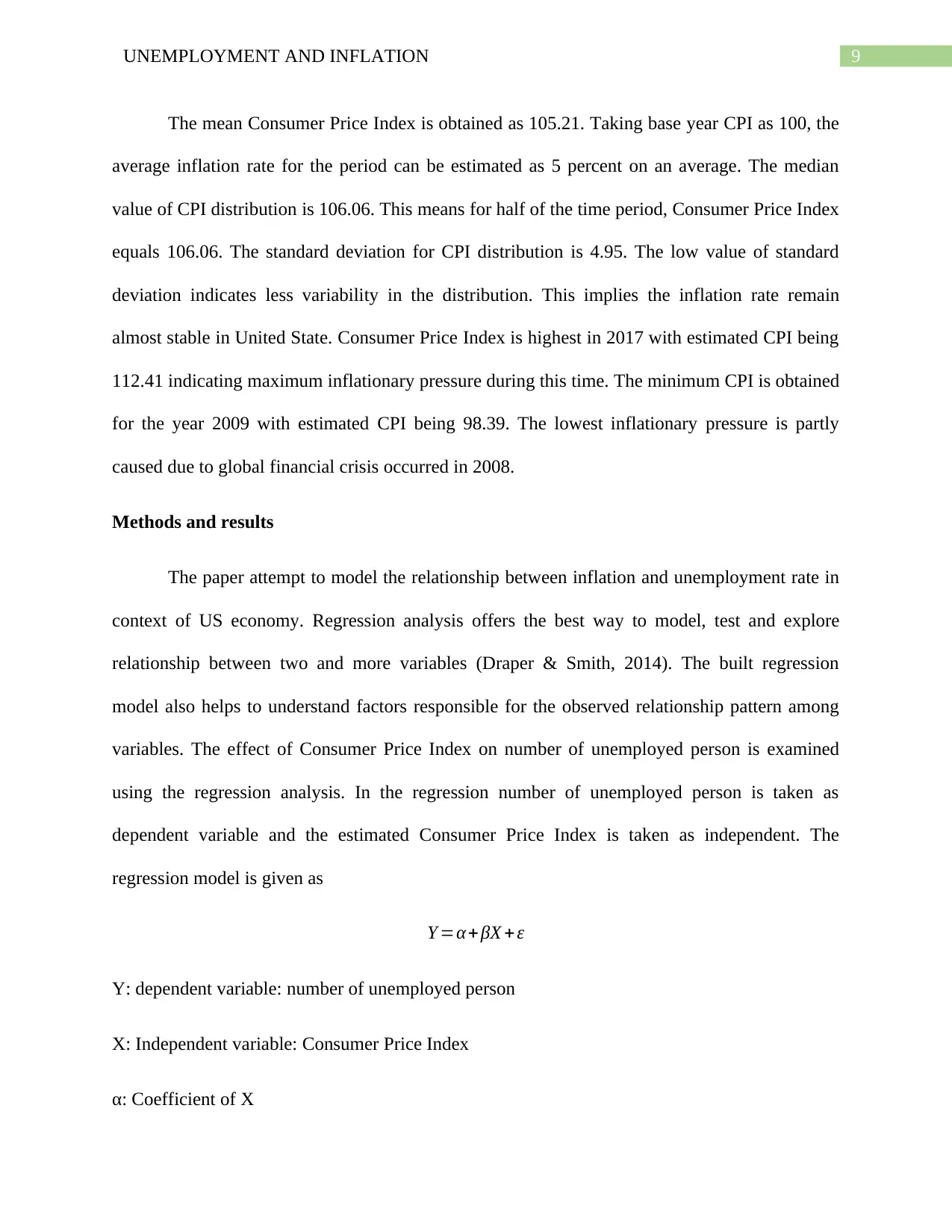
9UNEMPLOYMENT AND INFLATION
The mean Consumer Price Index is obtained as 105.21. Taking base year CPI as 100, the
average inflation rate for the period can be estimated as 5 percent on an average. The median
value of CPI distribution is 106.06. This means for half of the time period, Consumer Price Index
equals 106.06. The standard deviation for CPI distribution is 4.95. The low value of standard
deviation indicates less variability in the distribution. This implies the inflation rate remain
almost stable in United State. Consumer Price Index is highest in 2017 with estimated CPI being
112.41 indicating maximum inflationary pressure during this time. The minimum CPI is obtained
for the year 2009 with estimated CPI being 98.39. The lowest inflationary pressure is partly
caused due to global financial crisis occurred in 2008.
Methods and results
The paper attempt to model the relationship between inflation and unemployment rate in
context of US economy. Regression analysis offers the best way to model, test and explore
relationship between two and more variables (Draper & Smith, 2014). The built regression
model also helps to understand factors responsible for the observed relationship pattern among
variables. The effect of Consumer Price Index on number of unemployed person is examined
using the regression analysis. In the regression number of unemployed person is taken as
dependent variable and the estimated Consumer Price Index is taken as independent. The
regression model is given as
Y =α + βX +ε
Y: dependent variable: number of unemployed person
X: Independent variable: Consumer Price Index
α: Coefficient of X
The mean Consumer Price Index is obtained as 105.21. Taking base year CPI as 100, the
average inflation rate for the period can be estimated as 5 percent on an average. The median
value of CPI distribution is 106.06. This means for half of the time period, Consumer Price Index
equals 106.06. The standard deviation for CPI distribution is 4.95. The low value of standard
deviation indicates less variability in the distribution. This implies the inflation rate remain
almost stable in United State. Consumer Price Index is highest in 2017 with estimated CPI being
112.41 indicating maximum inflationary pressure during this time. The minimum CPI is obtained
for the year 2009 with estimated CPI being 98.39. The lowest inflationary pressure is partly
caused due to global financial crisis occurred in 2008.
Methods and results
The paper attempt to model the relationship between inflation and unemployment rate in
context of US economy. Regression analysis offers the best way to model, test and explore
relationship between two and more variables (Draper & Smith, 2014). The built regression
model also helps to understand factors responsible for the observed relationship pattern among
variables. The effect of Consumer Price Index on number of unemployed person is examined
using the regression analysis. In the regression number of unemployed person is taken as
dependent variable and the estimated Consumer Price Index is taken as independent. The
regression model is given as
Y =α + βX +ε
Y: dependent variable: number of unemployed person
X: Independent variable: Consumer Price Index
α: Coefficient of X
Paraphrase This Document
Need a fresh take? Get an instant paraphrase of this document with our AI Paraphraser

10UNEMPLOYMENT AND INFLATION
β: Constant
ε: Random error
Before developing the regression model an overview of the relation between inflation and
unemployment is presented using a scatter plot of the chosen variable. Figure 1 show the scatter
plot between Unemployment and Consumer Price Index measuring CPI on horizontal axis and
number of unemployed person on the vertical axis.
96 98 100 102 104 106 108 110 112 114
0
2000
4000
6000
8000
10000
12000
14000
16000
Unemployment
CPI
Unemployment
Figure 1: Scatter Plot of Unemployment and CPI
The scatter plot depicts an inverse relation between number of unemployed person and
Consumer Price Index. The fitted trend line slopes downward indicating a negative relation
between Unemployment and Consumer Price Index. As consumer price index increases, the
number of unemployed person decreases.
β: Constant
ε: Random error
Before developing the regression model an overview of the relation between inflation and
unemployment is presented using a scatter plot of the chosen variable. Figure 1 show the scatter
plot between Unemployment and Consumer Price Index measuring CPI on horizontal axis and
number of unemployed person on the vertical axis.
96 98 100 102 104 106 108 110 112 114
0
2000
4000
6000
8000
10000
12000
14000
16000
Unemployment
CPI
Unemployment
Figure 1: Scatter Plot of Unemployment and CPI
The scatter plot depicts an inverse relation between number of unemployed person and
Consumer Price Index. The fitted trend line slopes downward indicating a negative relation
between Unemployment and Consumer Price Index. As consumer price index increases, the
number of unemployed person decreases.

11UNEMPLOYMENT AND INFLATION
The relationship obtained between unemployment and CPI from the scatter plot is further
validated using the regression analysis. The result of the regression is given in the following
table
Table 2: Result of Regression
Regression Statistics
Multiple R 0.72
R Square 0.52
Adjusted R Square 0.46
Standard Error 2135.69
Observations 10
ANOVA
d
f SS MS F Significance F
Regression 1 38842536.81 38842536.81 8.51595 0.019344239
Residual 8 36489211.59 4561151.449
Total 9 75331748.4
Coefficient
s
Standard
Error t Stat P-value Lower 95%
Upper
95%
Intercept 54912.59 15119.15 3.63 0.01 20047.76 89777.43
CPI -418.92 143.55 -2.92 0.02 -749.96 -87.88
From the regression result, the estimated regression equation is
Y =54912.59−418.82 X + ε
The value of multiple R square is obtained as 0.72. The R square value shows explanatory power
of the independent variable (Chatterjee & Hadi, 2015). From the obtained R square value, it can
be said that Consumer Price Index can explain 72 percent variation in unemployment. Value of
the regression coefficient is obtained as -418.92. The negative regression coefficient indicates an
The relationship obtained between unemployment and CPI from the scatter plot is further
validated using the regression analysis. The result of the regression is given in the following
table
Table 2: Result of Regression
Regression Statistics
Multiple R 0.72
R Square 0.52
Adjusted R Square 0.46
Standard Error 2135.69
Observations 10
ANOVA
d
f SS MS F Significance F
Regression 1 38842536.81 38842536.81 8.51595 0.019344239
Residual 8 36489211.59 4561151.449
Total 9 75331748.4
Coefficient
s
Standard
Error t Stat P-value Lower 95%
Upper
95%
Intercept 54912.59 15119.15 3.63 0.01 20047.76 89777.43
CPI -418.92 143.55 -2.92 0.02 -749.96 -87.88
From the regression result, the estimated regression equation is
Y =54912.59−418.82 X + ε
The value of multiple R square is obtained as 0.72. The R square value shows explanatory power
of the independent variable (Chatterjee & Hadi, 2015). From the obtained R square value, it can
be said that Consumer Price Index can explain 72 percent variation in unemployment. Value of
the regression coefficient is obtained as -418.92. The negative regression coefficient indicates an
⊘ This is a preview!⊘
Do you want full access?
Subscribe today to unlock all pages.

Trusted by 1+ million students worldwide
1 out of 17
Related Documents
Your All-in-One AI-Powered Toolkit for Academic Success.
+13062052269
info@desklib.com
Available 24*7 on WhatsApp / Email
![[object Object]](/_next/static/media/star-bottom.7253800d.svg)
Unlock your academic potential
Copyright © 2020–2025 A2Z Services. All Rights Reserved. Developed and managed by ZUCOL.




